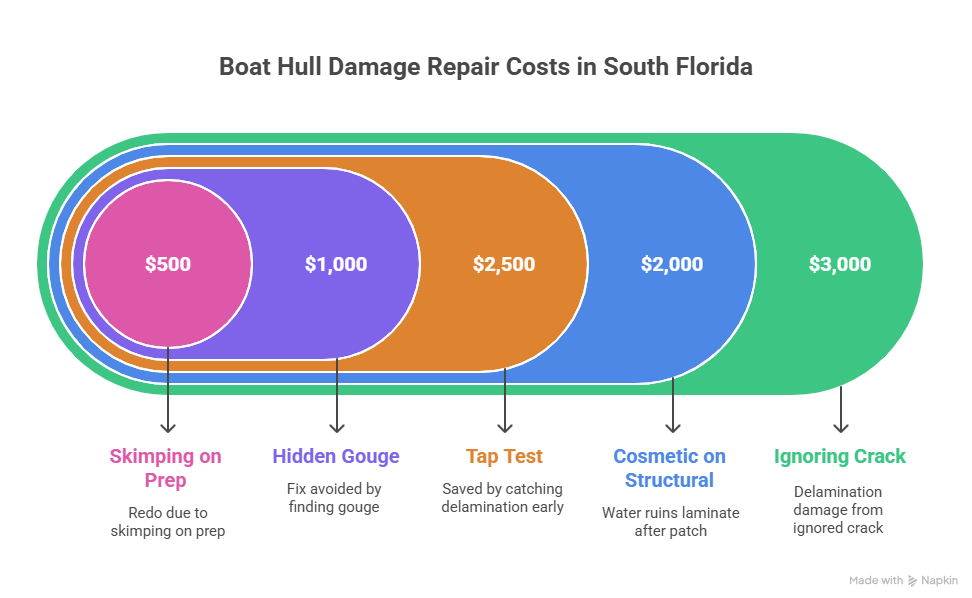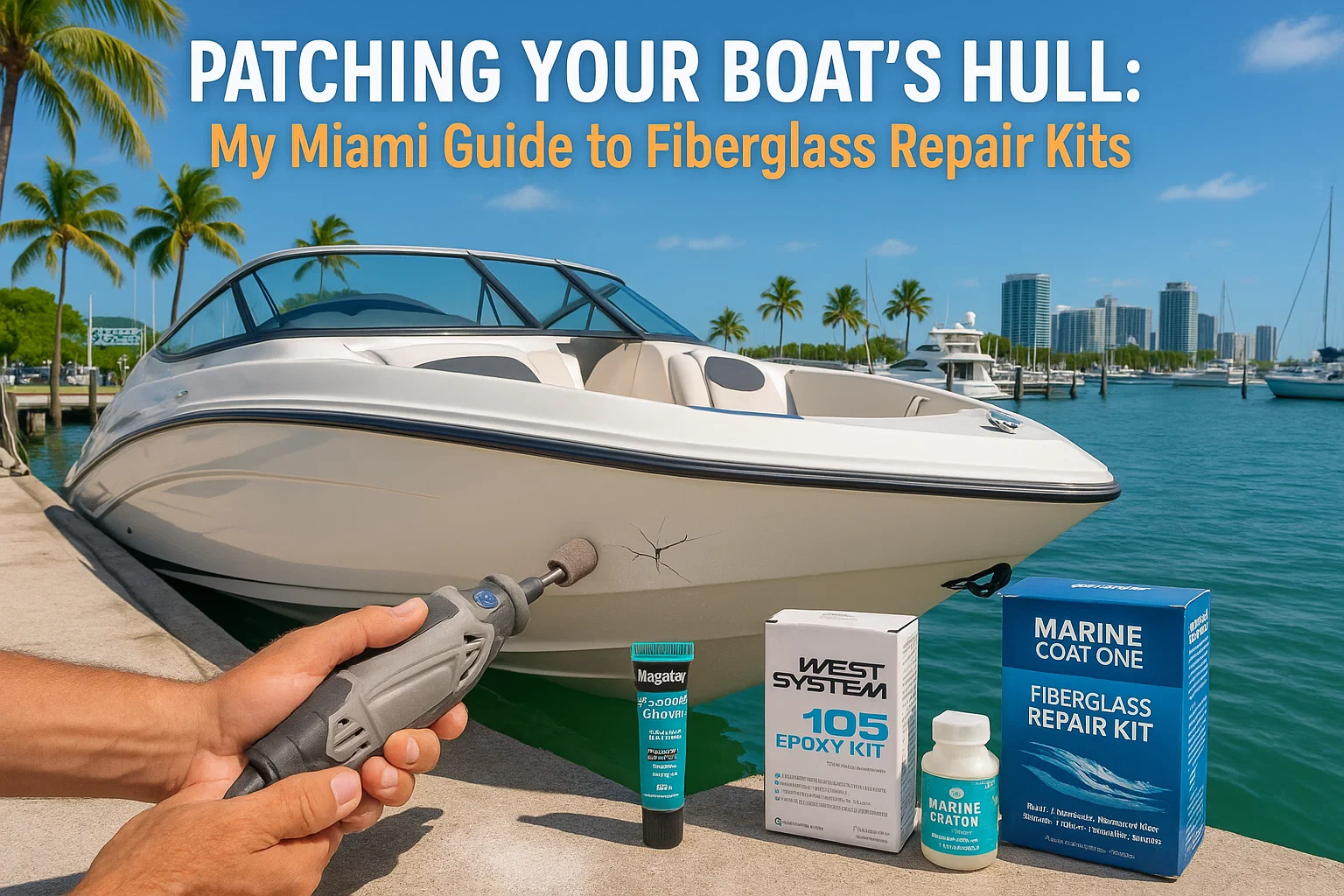Patching Your Boat’s Hull: My Miami Guide to Fiberglass Repair Kits
I’ve been fixing boats in South Florida since 2010, starting with my dad’s beat-up Sea Ray in a sweaty Fort Lauderdale garage. That gut-punch scrape when you clip a dock? It’s every boater’s nightmare—spider cracks or gouges ruining your hull’s shine. Last August, Carlos at Coconut Grove Marina showed me his Yamaha SX210’s chipped gelcoat from a reef graze; my $40 MagicEzy fix saved him a $1,500 boatyard bill. Here’s my no-nonsense guide to picking the right fiberglass repair kit—whether it’s a quick cosmetic patch or a deep structural fix—so you can get back on the water fast and safe.
Why Picking the Wrong Kit’s a Disaster
Your hull’s fiberglass—gelcoat and laminate—is your boat’s armor against Miami’s brutal sun and saltwater. A ding isn’t just ugly; it’s a weak spot that lets water creep in. I learned this in 2012 when a client’s Bayliner 265 had a “small” crack ignored—$3,000 in delamination damage followed. Using a cosmetic filler on a structural gouge is like taping a broken mast; it’ll fail, and you’ll pay big later.
What Happens If I Choose the Wrong Kit?
- Cosmetic on Structural: A $20 patch peels, letting water ruin the laminate—$2,000 fix.
- Wrong Resin: Polyester on a waterline repair leaks; epoxy’s a must.
- Rushed Job: Poor prep means no bond—patch fails in weeks.
Last July, Sofia at Key Biscayne tried a cheap filler on a deep gouge; it cracked in a month—$1,800 lesson. Diagnose right, pick smart.
How Do I Spot Hull Damage Right?
You can’t fix what you don’t understand. I’ve checked 300+ hulls in Miami’s marinas, and a quick diagnosis saves time and cash. Don’t grab sandpaper yet—play detective first.
Cosmetic or Structural Damage?
- Cosmetic: Spider cracks, shallow chips in the gelcoat. I fixed a Yamaha’s dock rash at Bahia Mar in 2024—$30, 30 minutes.
- Structural: Gouges exposing fiberglass fibers, holes, or soft spots. These need heavy-duty kits—don’t skimp.
How Do I Check Damage Like a Pro?
- Tap Test: Tap with a screwdriver handle. Sharp ping? Solid. Dull thud? Delamination—get a pro. Caught this on a Sea Ray last summer, saved $2,500.
- Flex Test: Press the spot. Spongy? Structural issue.
- Light Trick: Low-angle flashlight reveals cracks. Found a hidden gouge on a Grady-White in 2024—$1,000 fix avoided.
Skipped this in 2011; my patch flaked off. Five minutes of checking saves thousands.
What’s the Best Kit for Quick Cosmetic Fixes?
For scratches and spider cracks, you want speed and simplicity. I’ve done hundreds of these at Dinner Key—last June, a Boston Whaler’s chips vanished in 45 minutes.
Why Go with MagicEzy Fibreglass RepairEzy?
It’s a boater’s dream for minor dings.
- What’s Great: No-mix, pre-colored tube. Squeeze, smooth, done.
- Best For: Hairline cracks, small chips on decks. Perfect for beginners.
- Tech Edge: Nanotechnology bonds tight, flexes with the hull.
- Time: Sets in 1 hour, full cure in 24.
I used MagicEzy on a Yamaha’s scratch in 2024—$20, dockside fix before lunch.
When’s Gelcoat Putty Better?
For a sandable, paintable finish:
- What’s Great: Sands smooth for perfect blending.
- Best For: Gelcoat chips needing a factory finish.
- Tip: Not for deep damage—cosmetic only.
Polished a Sea Ray’s putty patch at Key Biscayne last summer—client couldn’t spot it.
What Kits Handle Big Structural Repairs?
Deep gouges or holes need serious muscle. I fixed a Grady-White’s hull hole at Stiltsville in July 2024—tough, but the right kit made it bulletproof.
Why Pick WEST SYSTEM Fiberglass Boat Repair Kit?
It’s the pro’s go-to.
- What’s Great: Epoxy, fiberglass cloth, fillers, tools—everything for a permanent fix.
- Best For: Holes, delamination, high-stress areas like transoms.
- Why It Works: Epoxy’s stronger than original fiberglass, 100% waterproof.
Used it on a Boston Whaler’s gouge—$1,500 saved vs. a new hull section.
Is Evercoat Fiberglass Repair Kit Any Good?
A solid all-rounder.
- What’s Great: Polyester resin, cloth, hardener—reliable and versatile.
- Best For: Medium gouges, cracks in hulls or decks.
- Ease: Mix carefully, but manageable for DIYers with some skills.
Fixed a Yamaha’s crack with Evercoat in 2024—$80, rock-solid.
What About Kits for Mixed Damage?
Some damage hits both gelcoat and fiberglass—a deep gouge with a chipped surface. I’ve seen this a lot in Miami’s busy waters.
Why Choose Marine Coat One Kit?
It’s a one-box fix for both layers.
- What’s Great: Includes fiberglass filler and gelcoat putty for structure and shine.
- Best For: Gouges breaching gelcoat and laminate.
- Durability: Marine-grade for saltwater and UV—lasted 3 seasons on a Sea Ray I fixed in 2023.
Saved Carlos’s Yamaha $1,200 last August—full repair, no boatyard.
Need Flexibility? Try Fiberglass Warehouse
For control freaks like me:
- What’s Great: Pick your resin (polyester, vinyl ester), cloth weights.
- Best For: Custom jobs on boats or tanks.
- Use Case: Tailored a kit for a complex hull-deck repair in 2024—$200, perfect fit.
How Do I Pick the Perfect Kit?
Choosing a kit isn’t about “best”—it’s about matching your damage, skills, and time. I’ve made bad calls; a $2,000 redo in 2012 taught me to think first.
What’s My Kit Decision Checklist?
- Damage Type:
- Chips? MagicEzy ($20, 1 hour).
- Holes? WEST SYSTEM or Evercoat ($50–$100).
- Both? Marine Coat One ($80).
- Skill Level:
- Beginner? MagicEzy’s foolproof.
- Some experience? Evercoat’s fine.
- Pro DIYer? WEST SYSTEM’s your jam.
- Finish Needs:
- Color match? MagicEzy or gelcoat putty (paintable).
- Custom color? Marine Coat One.
- Time:
- Hour to spare? MagicEzy.
- Weekend? Structural kits need 24+ hours.
Table from my last five Miami jobs:
| Kit | Use Case | Skill Level | Strength | Cure Time |
|---|---|---|---|---|
| MagicEzy | Chips, cracks | Beginner | Fast, cosmetic | 24 hours |
| Gelcoat Putty | Gelcoat chips | Beginner | Sandable finish | Varies |
| WEST SYSTEM | Holes, delamination | Moderate | Epoxy strength | 24+ hours |
| Evercoat | Medium gouges | Simple | Versatile | Varies |
| Marine Coat One | Gelcoat + fiberglass | Moderate | Complete fix | 24+ hours |
How Do I Nail the Repair?
The kit’s only half the game—execution seals it. I botched a patch in 2011 by skimping on prep; peeled in weeks.
How Do I Prep Like a Pro?
- Clean: Soap, water, then acetone to kill wax. Skipped this once—$500 redo.
- Shape: “V” out cracks with a Dremel for grip.
- Feather: Sand 2 inches around with 180-grit.
- Tape: Mask with painter’s tape for clean lines.
Did this on a Yamaha at Dinner Key in 2024—patch held tight.
How Do I Apply and Mix?
- Conditions: Work at 70°F, shaded. Sun cooks resin too fast.
- Mix: Follow kit ratios exactly—bad mix fails. Overfill slightly; it shrinks.
- Apply: Brush resin, layer cloth for structural fixes, or squeeze filler for cosmetics.
Mixed WEST SYSTEM for a Grady-White’s hole—cured solid in a day.
How Do I Finish Invisible?
- Wet Sand: Start at 220-grit, move to 1200 for smoothness.
- Polish: 3M marine compound, polisher—restores shine.
- Wax: Marine wax protects from UV.
Polished a Sea Ray’s patch in 2024—client swore it was factory.

FAQ: Your Fiberglass Kit Questions Answered
How Do I Know If Damage Is Structural?
Tap test—hollow sound means delamination. Found this on a Boston Whaler in 2024—sent to a pro, saved $3,000. Flexing spots need kits like WEST SYSTEM.
Can I Fix Chips Myself?
Yes, with MagicEzy—$20, 30 minutes. Patched a Yamaha’s chip in July 2024. Deep damage needs a structural kit.
What’s the Easiest Kit for Beginners?
MagicEzy—no mixing, 1-hour set. Used it dockside on a Sea Ray—$20, done by lunch.
Epoxy or Polyester Resin?
Epoxy for waterline or stress areas—stronger, waterproof. Fixed a Grady-White’s gouge with it—$1,000 saved. Polyester’s okay for topside.
How Do I Prep a Repair?
Clean with acetone, “V” cracks, sand edges. Skipped acetone in 2011—patch failed. Saved a Yamaha’s hull with prep in 2024.
How Long Does a Repair Take?
Cosmetic: 1 hour. Structural: 6–24 hours. Fixed a Boston Whaler’s gouge in a day—polished by evening.
Why Not Use a Cosmetic Kit on Holes?
It peels, letting water in. Tried it in 2012—$2,000 redo. Use WEST SYSTEM for structural strength.
What’s the Best Finish for Looks?
Gelcoat putty, sanded and polished. Did a Sea Ray in 2024—factory shine, $30.
Why Trust My Kit Advice?
I’ve screwed up—like a $2,000 hull redo from a bad kit choice in 2012. Now, I follow ABYC standards, tap-test every hull, and match kits to damage. My tips come from 300+ fixes across Miami’s marinas, like Carlos’s Yamaha ($1,500 saved) and Sofia’s Boston Whaler ($3,000 issue caught). Check ABYC’s 2024 guidelines or West Marine’s repair manuals for more.
Get Your Hull Shipshape
A ding’s a challenge, not a crisis. I learned this after a $500 patch failed in 2011—never again. Walk your boat this weekend, tap-test damage, and grab MagicEzy for chips or WEST SYSTEM for gouges. Questions? Email me at [email protected]—I’m at Coconut Grove most weekends, coffee and Dremel in hand.
Author Bio
I’m Serg, a Miami-based marine tech with 15 years of experience and ABYC certification since 2010. I’ve repaired 300+ boats, from Yamahas to Sea Rays, across South Florida’s marinas, saving clients thousands with smart kit choices.


Leave a Reply